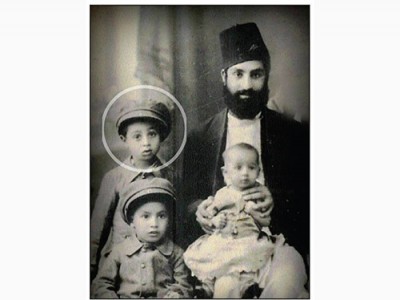
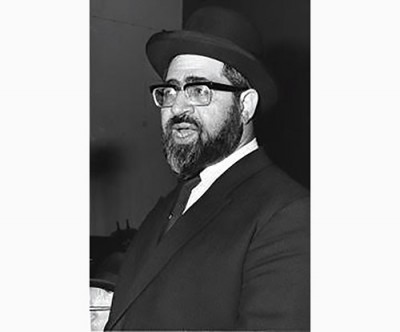
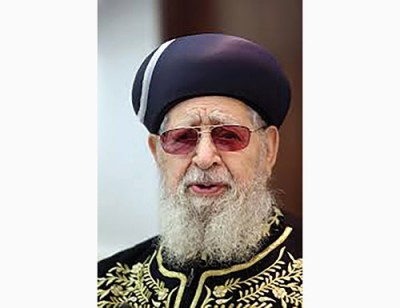
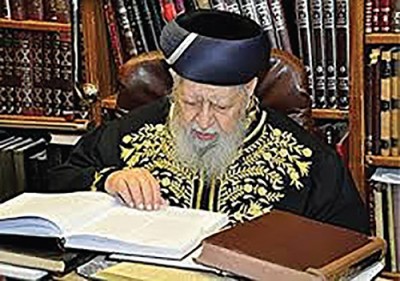
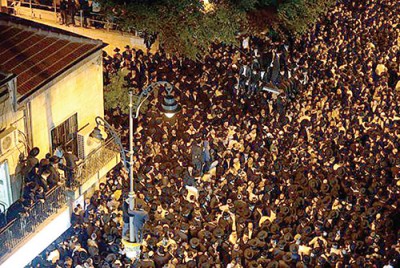
July 23, 1984:
Israeli election results were in! The results indicated that the Alignment and Likud parties would form a coalition government (When a political party wins the most seats in Knesset but not the majority of Knesset it will merge with another successful party and form a government where the chairmen of the two parties are typically Prime Minister for two years each). But in a small apartment room on Jabotinsky Street, sat one man whose mission through life was LeHachzir Atarah Leyeshona–to restore the crown of Sephardic Jewry to its former grandeur. He had also triumphed. The radios blared; informing the fellow that Shas, his newly founded political party whose goal was to spread Torah knowledge throughout Israel, controlled four seats in Knesset. Instead of celebrating, the scholarly man resumed the study of his beloved Torah as if Shas controlled no seats in Knesset. Who was this remarkable fellow? None other than Maran HaRav Ovadia Yosef zt”l, the celebrated illuy or genius, a former Sephardic Chief Rabbi of Israel and Rishon LeZion. Read on to find out more about him and the impact he had on modern-day Sephardic Jewry!
Maran Harav Ovadia Yosef zt”l was born to Mr. Yaakov and Mrs. Georgia Ovadia1 in Baghdad, Iraq on September 23, 1920. When HaRav Ovadia was three years old, a serpent slithered it’s way into his unattended carriage and would have fatally injured HaRav Ovadia if not for an Arab neighbor who saw the snake and killed it. Hashgaha Pratit2 was already developing a role in the life of HaRav Ovadia!
HaRav Ovadia attended Talmud Torah Bnei Zion throughout his childhood. His praise for Talmud Torah was such that he stated: “If not for Rav Moshe Porush Talmud Torah’s founder) Torah would have been forgotten from Sephardic Jewry.”
When Ovadia was six-years-old, he urged his Rebbi, Rav Natan Salam, to teach him Gemara after Talmud Torah dismissed. When asked by his son, Rav David Yosef why he didn’t yearn to play amongst the children his age he answered: “When I began learning Gemara, I lost interest in participating.”
In the dead of night, a ten-year-old Ovadia roused. After hastily getting dressed he hurried out to Beit Yisrael, a community close to Yerushalayim’s local Beit Midrash. He would study Torah for several hours, returning home before sunrise. Later in life, HaRav Ovadia would suffer from eyesight complications and would be forced to don high-prescription dark red sunglasses (even while indoors) as a result of studying Torah under the moonlight throughout his childhood. HaRav Ovadia’s brother, Na’im Ovadia, related that HaRav Ovadia once snuck out of the house to study Torah exceptionally early in the morning and could not find his shoes. So as not to wake the Ovadia family during a search for his shoes, he slipped on multiple pairs of socks and walked to the local Beit Midrash despite intense pain.
In 1930, after having completed Talmud Torah’s extensive curriculum, Ovadia (who was ten-years-old at the time) accompanied his father, R’ Yaakov on a six-month business trip to his hometown, Baghdad. One day, Ovadia asked R’ Yaakov if he could quietly study inside Yeshiva Beit Midrash Zilcha, a famous Beit Midrash within Baghdad. After explaining to several grown men why they misunderstood a Tosafot, he was approached by the Beit Midrash’s Rosh HaYeshiva, Rav Salman Hugi Aboudi and commanded to state all the Mishnayot and Gemara he had learned over the course of his life. HaRav Ovadia humbly replied: “Mishnayot Masechet Shabbat.” As Rav Aboudi was skeptical that HaRav Ovadia had only studied one Masechet of Mishnayot he pressed on and eventually Ovadia was forced to say: “I have learned the entire Mishnayot Seder Mo’ed, Nashim, and Nezikim as well as three Perakim of Gemara Masechet Bava Kamma and two Perakim of Gemara Masechet Bava Metzia.” Rav Aboudi decided to quiz HaRav Ovadia by asking him to recite a Tosafot in Perek HaMafkid in Gemara Masechet Bava Metzia. After he did this, Rav Aboudi summoned HaRav Ovadia’s father, Rav Yaakov and advised him to enroll HaRav Ovadia in Yeshiva Porat Yosef in Yerushalayim even though all the students in Yeshiva Porat Yosef were above the age of Bar Mitzvah.
HaRav Ovadia was able to attend Yeshiva Porat Yosef for three months. However, following the school year of 1931, he was pulled out of Yeshiva Porat Yosef because HaRav Ovadia’s father, R’ Yaakov, feared that Arab mobs storming the Old City would harm or, lo aleinu, kill his ingenious son. He would return, for lack of a safer religious Yeshiva on his level, in the winter of 1932 and would study in Yeshiva Porat Yosef until 1947. During these years he would meet Rav Ezra Attia, his primary mentor for the rest of his life.
HaRav Ovadia’s father, R’ Yaakov, owned a grocery store which brought in just barely enough money to support the Ovadia family. Since R’ Yaakov could not afford to hire employees, he once again pulled his son out of Yeshiva Porat Yosef to stock the shelves of his grocery and attend to customers. Rav Attia immediately noticed that HaRav Ovadia was absent. When he heard of R’ Yaakov Ovadia’s predicament, he immediately volunteered to work at the grocery for two hours a day so that HaRav Ovadia could study in Yeshiva Porat Yosef. During his hours at the grocery, HaRav Ovadia brought a heap of Sefarim to his father’s supermarket and studied throughout every available moment. Eventually, aspiring thieves took notice of his habit and stole merchandise while HaRav Ovadia had his head down. When Rav Yaakov realized he was losing more than he was gaining by employing HaRav Ovadia, he dismissed him saying: “A grocer you will never be, just go and learn.” As HaRav Ovadia’s brother, Na’im Ovadia, said: “I am sure that the thieves who stole from my father were really malachim, angels, dressed up like thieves to ensure that my brother, HaRav Ovadia, could study more Torah in Yeshiva Porat Yosef”!
In 1937, at the age of seventeen, HaRav Ovadia published his first work, Yabia Omer, on Gemara Masechet Horayot. Furthermore, he began delivering a nightly shiur in Beit Knesset Ohel Rahel (whose gabbai at the time was the famed mekubal, Rav Yitzchak Kadouri) on David Yellin Street in Geula. He was fired for disagreeing with the Ben Ish Hai but was then quickly hired by Beit Knesset Shaul Tzadka to deliver shiurim. Thus began a lifelong bond of HaRav Ovadia with Persian Jewry. HaRav Ovadia’s most famous shiurim including his Motzei Shabbat shiur, which would make history as the largest audience for any shiur throughout the world, was directed primarily towards Persian Jewry. HaRav Ovadia received Rabbinic Ordination in 1940 and married Rebbetzin Margalit Yosef (née Fattal) on March 28, 1944.
HaRav Ovadia joined the Beit Din HaSephardim in Yerushalayim immediately after his marriage in 1944 (at the age of twenty-three). His next position in Dayanut would be offered in 1947, three years later. He would become Deputy Chief Rabbi of Egypt and Rosh HaYeshiva of Yeshiva Ahava V’Ahava upon the recommendation of Rav Ezra Attia, his mentor. After fighting significant battles regarding shehita or slaughtering, and kashrut, he resigned in 1950. Laxity in these standards throughout the world would eventually lead him to found Badatz Beit Yosef, a kashrut organization, which is currently under the leadership of Rav Moshe Yosef. Below is the story of Shimon A., a shohet or slaughterer who tormented HaRav Ovadia in Egypt:
Shimon A. was the “Chief Shohet” of Egypt when HaRav Ovadia arrived there in 1947. Rumors had abounded over the years about Shimon A. and how he and other corrupt shohetim, I quote HaRav Ovadia: “ (They) have turned shehita into little more than a source of income.” In 1948, rumors became a reality when Mashgiah Yihye Levi accused Shimon of ordering him to place a seal with the word Kosher on a meat package while the meat was actually slaughtered by a non-Jew thus rendering it treif, non-Kosher. Combined with many testimonies of Shimon’s general laxity towards kashrut, this scandal cost Shimon his job. R’ Massoud Elbaz, a noted shohet from Alexandria, was appointed by HaRav Ovadia in his stead. Shimon was in an uproar and committed himself to annihilate HaRav Ovadia. Shimon created fantasies concerning HaRav Ovadia and told them to the Egyptian government. Luckily, HaRav Ovadia was quite capable of convincing the Egyptian government that the supposed accusations were false. Shimon then opened a butcher shop, realizing he could no longer slaughter meat. After R’ Massoud Elbaz, the shohet who possessed his former position caught him red-handed selling non-Kosher beef to a young lady and reported this to HaRav Ovadia (who assured R’ Elbaz that a mashgiah would be present throughout Shimon’s working hours from that day on). Upon learning this, Shimon walked into HaRav Ovadia’s Beit Din and leveled a gun at HaRav Ovadia’s head declaring: “I will kill any man that stunts my growth.” HaRav Ovadia coolly told Shimon that Jews throughout history have departed for the Torah’s sake and that a gun would not frighten him. Shimon stormed out of Beit Din, and he and his brother-in-law Araf hired Arabs to pour liquid acid, which they provided, on HaRav Ovadia when he left the Beit Knesset after Arvit. Hashgaha Pratit would once again side with HaRav Ovadia–he did not attend his daily minyan that night. R’ Elbaz, the Chief Shohet who Shimon also despised of, left Beit Knesset that night and heard a civilian’s voice cry out: “R’ Elbaz, can you help me”? He whipped around to find nothing but thin air and at that moment Shimon’s thugs, mistaking him for HaRav Ovadia, poured the liquid acid on his head. R’ Elbaz was hospitalized but suffered no lasting damage. Doctors later informed him that if he had been facing forward at the time, he would have been permanently blinded.
HaRav Ovadia suffered through many comparable assaults, in Egypt, and in Israel, before one day Shimon disappeared and was not heard from for years. HaRav Ovadia’s son, Yaakov, later learned that Shimon had ultimately joined a criminal gang and was killed during a feud with a fellow member. HaRav Ovadia’s love for Torah was such that he was willing to risk his own life, at the hands of a ruffian, to defend it!
HaRav Ovadia’s next position was that of Chief Rabbi of Tel Aviv. He shared this office as well as that of the Chief Rabbi of Israel with former IDF Chief Rabbi, Rav Shlomo Goren and held it from 1968 until 1973. HaRav Ovadia argued with Rav Goren’s Piskei Halacha in the two most significant cases of their term in the Rabbanut of Tel Aviv, the specifics of which will not be expounded upon in this article.
HaRav Ovadia’s final position (excluding his role in the Shas political party–mentioned above) was that of Sephardic Chief Rabbi of Israel and Rishon LeZion. During his ten years in this office, from 1973 until 1983, his primary concern was to free the agunot (a widow that has no proof of their husband’s passing is called an agunah and cannot halachically remarry until evidence of her husband’s death is found) of the Yom Kippur War. Below is the story of a false agunah:
HaRav Ovadia was once approached by a supposed agunah who broke down crying and asked HaRav Ovadia to write her up a heter agunah (a heter agunah is a document, usually written by a trustworthy Rabbi that allows an agunah to remarry). HaRav Ovadia deduced that she was lying and informed her that she should come back the following day and all would become clear (The woman took this as a sign that HaRav Ovadia would write her up a heter agunah the next morning). This woman had actually devised a plot with her living husband to frame HaRav Ovadia. Immediately after leaving HaRav Ovadia’s apartment the woman called her husband and notified him that their plan was succeeding thus far. The moment the woman’s husband walked across the threshold of their house later that night he collapsed and died. HaRav Ovadia’s prophetic words rung in this woman’s ears: “Come back tomorrow and everything will be clear”! From that fateful day onwards, no one ever schemed against HaRav Ovadia Yosef.
HaRav Ovadia Yosef zt”l passed away on October 7, 2013, following a ten-day coma. He is survived by his children (with the exception of Rav Ya’akov Yosef and Rachel Yosef, who passed away as an infant), the current Rishon LeZion, Yitzchak Yosef, Rav Dovid Yosef, Rav Moshe Yosef (the current head of Badatz Beit Yosef kashrut organization), Adina Bar-Shalom, Malca Sasson, Yafa Cohen, Leah Butbul, Sarah Toledano, and Rivka Chikotai as well as his tens of holy s’farim.
The morning after the death of HaRav Ovadia, Rav Benzion Mutzafi, another Sephardi gadol ha’dor, took a taxi ride to Yerushalayim. The distinctly non-religious taxi driver turned to Rav Mutzafi and told him: “I have no interest in working today.” “Why?” Rav Mutzafi asked him.” “Maran (HaRav Ovadia Yosef) is gone, what do we have to live for”? Such was the impact of HaRav Ovadia Yosef on Jewry – even a non-religious taxi driver mourned him! As billboards in Israel read in the weeks before his passing:
Ohavim Otecha, Maran – We love you, Maran.
And after his passing:
- Yesomim Hayyinu VeAin Av – We are orphans, and we have no father!
- Sources: Maran HaRav Ovadia – By. Rabbi Yehuda Heimowitz
Tovia, not Tuvia, Paris is currently entering the seventh grade class of Yeshiva Tiferes Moshe. Between writing articles for the Queens Jewish Link and enjoying a break from his homework, he is busy preparing for his upcoming Bar Mitzvah. He can be reached at This email address is being protected from spambots. You need JavaScript enabled to view it..
By Tovia Paris
Typography
- Smaller Small Medium Big Bigger
- Default Helvetica Segoe Georgia Times
- Reading Mode




